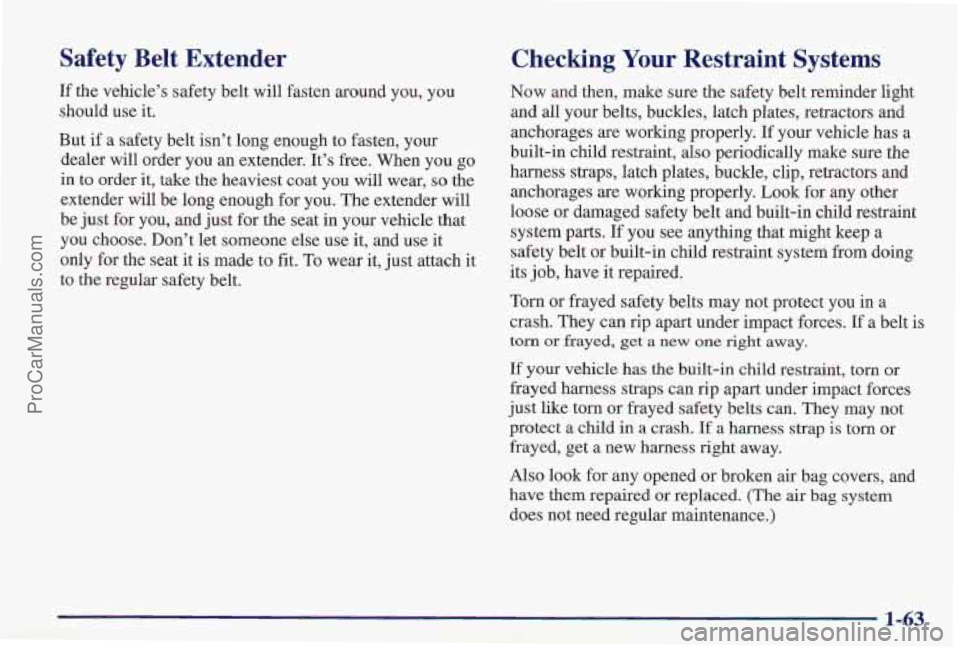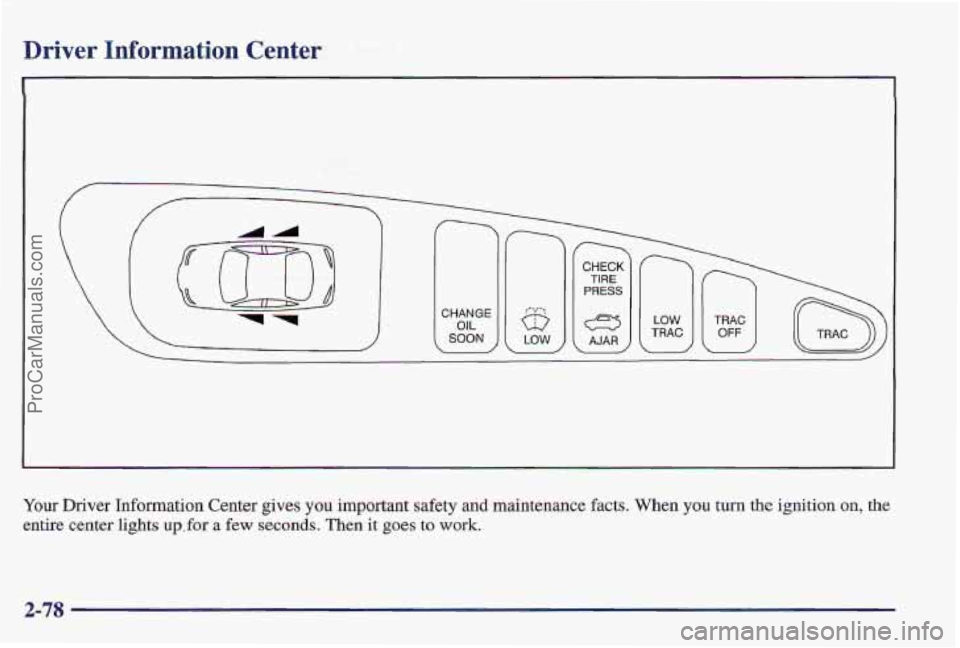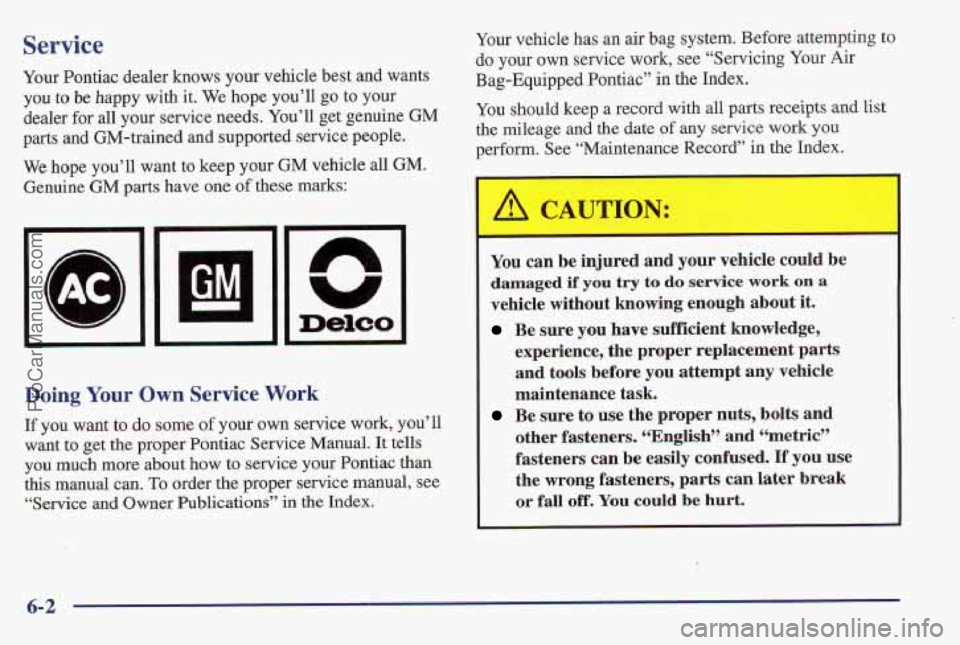1997 PONTIAC PONTIAC maintenance
[x] Cancel search: maintenancePage 3 of 419

The 1997 Pontiac Grand Prix Owner’s Manual
1-1
2- 1
3- 1
Seats and Restraint Systems
This section tells you how to use your seats and safety belts\
properly. It also explains the “SRS” system.
Features and Controls
This section explains how to start and operate your Pontiac.
Comfort Controls and Audio Systems
This section tells you how to adjust the ventilation and comfo\
rt controls and how to operate your audio system.
4- 1 Your Driving and the Road
Here you’ll find helpful information and tips about the road\
and how to drive under different conditions.
This section tells what to do
if you have a problem while driving, such as a flat tire or ove\
rheated engine, etc.
5-1 Problems on the Road
6- 1
7-1
Service and Appearance Care
Here the manual tells you how to keep your Pontiac running pr\
operly and looking good.
Maintenance Schedule
This section tells you when to perform vehicle maintenance and \
what fluids and lubricants to use.
8- 1 Customer Assistance Information
This section tells you how to contact Pontiac for assistance and how to get service and owne\
r publications.
It also gives you information on “Reporting Safety Defects” on page
8-10.
Here’s an alphabetical listing of almost every subject in this manual. You can use it to quickly find
something you want to read.
9-1 Index
i
ProCarManuals.com
Page 35 of 419

0 Your vehicle is equipped with a crash sensing and
diagnostic module, which records information
about the air bag system. The module records
information about the readiness
of the system,
when the sensors are activated and driver’s safety
belt usage at deployment.
bag system. Improper service can mean that your
air bag system won’t work properly.
See your
dealer
for service.
Let only qualified technicians work on your air
NOTICE:
Servicing Your Air Bag-Equipped Pontiac
Air bags affect how your Pontiac should be serviced.
There are parts
of the air bag system in several places
around your vehicle. You don’t want the system to
inflate while someone is working on your vehicle. Your
Pontiac dealer and the Grand Prix Service Manual have
information about servicing your vehicle and the air bag
system.
To purchase a service manual, see’ “Service and
Owner Publications” in the Index.
If you aarnage the cover for the driver’s or the
right front passenger’s air bag, the bag may not
work properly. You may have
to replace the air
bag module in the steering wheel or both the air
bag module and the instrument panel for the
right front passenger’s
air bag. Do not open or
break the air bag covers.
1 r up to 10 1 nutes af th gn. )n: y is
turned off and the battery is disconnected, an air
bag can still inflate during improper service. You
can be injured
if you are close to an air bag when
it inflates. Avoid wires wrapped with yellow tape
or yellow connectors. They are probably part of
the air bag system. Be sure to follow proper
service procedures, and make sure the person
performing work for you
is qualified to do so.
The air bag system does not need regular maintenance.
1-27
ProCarManuals.com
Page 71 of 419

Safety Belt Extender
If the vehicle’s safety belt will fasten around you, you
should use it.
But
if a safety belt isn’t long enough to fasten, your
dealer will order you an extender. It’s free. When you
go
in to order it, take the heaviest coat you will wear, so the
extender will be long enough for you. The extender will
be just for you, and just for the seat in your vehicle that
you choose. Don’t let someone else use it, and use it
only for the seat it is made to fit. To wear it, just attach it
to the regular safety belt.
Checking Your Restraint Systems
Now and then, make sure the safety belt reminder light
and all your belts, buckles, latch plates, retractors and
anchorages are working properly.
If your vehicle has a
built-in child restraint, also periodically make sure the
harness straps, latch plates, buckle, clip, retractors and
anchorages are working properly.
Look for any other
loose or damaged safety belt and built-in child restraint
system parts. If you see anything that might keep a
safety belt or built-in child restraint system from doing
its job, have it repaired.
Torn or frayed safety belts may not protect you in a
crash. They can rip apart under impact forces.
If a belt is
torn or frayed, get a new one right away.
If your vehicle has the built-in child restraint, torn or
frayed harness straps can rip apart under impact forces
just like torn or frayed safety belts can. They may not
protect a child in a crash.
If a harness strap is torn or
frayed, get a new harness right away.
Also look for any opened or broken air bag covers, and
have them repaired or replaced.
(The air bag system
does not need regular maintenance.)
1-63
ProCarManuals.com
Page 152 of 419

Driver Information Center
. ~ = .. .. .. -. .
. .. - .. .. -. . .. - .
I
CHANGE OIL SOON c
Your Driver Information Center gives you important safety and maintenance facts, When you turn the ignition on, the
entire center lights ug.for a few seconds. Then it goes to work.
2-78
ProCarManuals.com
Page 232 of 419

Parking on Hills
You really should not park your vehicle, with a trailer
attached,
on a hill. If something goes wrong, your rig
could start to move. People
can be injured, and both
your vehicle and the trailer can be damaged.
But
if you ever have to park your rig on a hill, here’s
how to do it:
1. Apply your regular brakes, but don’t shift into
2. Have someone place chocks under the trailer wheels.
3. When the wheel chocks are in place, release the
regular brakes until the chocks absorb the load.
4. Reapply the regular brakes. Then apply your parking
brake, and then shift to
FARM (P).
5. Release the regular brakes.
PARK (P) yet,
When You Are Ready to Leave After
Parking on a Hill
1. Apply your regular brakes and hold the pedal down
while you:
Start your engine;
Shift into a gear; and
0 Release the parking brake.
2. Let up on the brake pedal.
3. Drive slowly until the trailer is clear of the chocks.
4. Stop and have someone pick up and store the chocks.
Maintenance When Trailer Towing
Your vehicle will need service more often when you’re
pulling
a trailer. See the Maintenance Schedule for more
on this. Things that are especially important in trailer
operation are automatic transaxle fluid (don’t overfill),
engine oil, belts, belt, cooling system and brake
adjustment. Each
of these is covered in this manual, and
the Index will
help you find them quickly. If you’re
trailering, it’s a good idea to review these sections
before you start your trip.
Check periodically to see that all hitch nuts and bolts
are tight.
4-38
ProCarManuals.com
Page 271 of 419

Section 6 Service and Appearance Care
Here you will find information about the care of your Pontiac. This section begins with service and fuel information,
and then it shows how to check important fluid and lubricant levels. There
is also technical information about your
vehicle, and a part devoted to its appearance care.
6-2
6-3 6-5
6-5
6-7
6- 14
6-2 1
6-26
6-32
6-33 6-36
6-37
6-37 6-44
6-46
Doing Your Own Service Work
What Kind of Fuel to Use
Using Fuel in Foreign Countries
Where to Put the Fuel and Filling the Tank
Checking
Things Under the Hood
Checking Your Engine Oil
Automatic Transaxle Fluid
Engine Coolant
Where to Fill the Windshield Washer Fluid
Important Brake Information
Information on Your Vehicle’s Battery
Tips on Vehicle Storage
Bulb Replacement Procedures
Windshield Wiper Blade Replacement
How and When to Check Tire Inflation 6-50
6-52
6-55
6-58
6-59
6-61
6-63
6-64
6-65 6-66
6-66
6-72
6-72
6-73
6-73 When
it is Time to Buy New Tires
Wheel Alignment
Cleaning the Inside of Your Vehicle
Care of the Safety Belts and Built-in
Child Restraint
Cleaning the Outside of Your Vehicle
How to Clean Aluminum Wheels
Underbody Maintenance
Recommended Appearance
Care Materials
Your Vehicle Identification Number (VIN)
The Electrical System
Fuses and Circuit Breakers
Replacement Bulb Types for Your Vehicle
Capacities and Specifications
Air Conditioning Specifications
Normal Replacement Parts
ProCarManuals.com
Page 272 of 419

Service
Your Pontiac dealer knows your vehicle be,st and wants
you
tu be happy with it. We hope you’ll go to your
dealer
for all your service needs. You’ll get genuine GM
parts and GM-trained and supported service people.
We hope you’ll want to keep
your GM vehicle all GM.
Genuine GM parts have one of these marks:
Deleo
-.
Doing Your Own Service . hrk
~~
If you want to do some of your own service work, you’ll
want
to get the groper Pontiac Service Manual. It tells
you
much more about how to service your Pontiac than
this manual can.
To order the proper service manual, see
“Service and O’wner
Publications” in the Index. Your
vehicle
has an air bag system. Before attempting to
do your own sewice work, see “Servicing Your Air
Bag-Equipped Pontiac”
in the Index.
You should keep a record with all parts receipts and list
the mileage and the date of any service work you
perform, See “Maintenance Record” in the Index,
You can be injured and your vehicle could be
damaged if you try to do service work on a
vehicle without knowing enough about it.
Be sure you have sumcient knowledge,
experience, the proper replacement parts
and tools before you attempt any vehicle
maintenance
task.
Be sure to use the proper nuts, bolts and
other fasteners. C‘English” and (‘metric”
fasteners can be easily confused,
If you use
the wrong fasteners, parts can
later break
or fall off. You could be hurt.
6-2
ProCarManuals.com
Page 288 of 419

NOTICE:
Use only engine oil with the American Petroleum
Institute Certified For Gasoline Engines
“Starburst” symbol. Failure to use the
recommended oil can result in engine damage not
covered by
your warranty.
GM Goodwrench@ oil meets all the requirements for
your vehicle.
If you are in an area where the temperature falls below
-20°F (-29*C), consider using either an SAE 5W-30
synthetic oil or an SAE OW-30 oil. Both will provide
easier cold starting and better protection
for your engine
at extremely low temperatures.
Engine Oil Additives
Don’t add anything to your oil. Your Pontiac dealer is
ready
to advise if you think something should be added.
When to Change Engine Oil
If any one of these is true for you, use the short trip/city
maintenance schedule:
0 Most trips are less than 5 to 10 miles (8 to 16 km).
This
is particularly important when outside
temperatures are below freezing.
0 Most trips include extensive idling (such as frequent
driving in stop-md-go traffic).
0 Most trips are through dusty areas.
You frequently tow a trailer or use a carrier on top of
0 The vehicle is used for delivery s’ervice, police, taxi
Driving und’er these conditions causes engine oil to
break down sooner, If any one
of these is true €or your
vehicle, then you need to change your oil and filter
every
3,000 miles (5 000 km) or 3 months -- whichever
occurs first. (See “Change Oil Indicator” in the Index.)
If none of them is true, use the long triphighway
maintenance
schedule. Change th’e oil and filter every
7,500 miles (12 500 km) or 12 months -- whichever
occurs first, Driving
a vehicle with a fully warmed
engine under highway conditions causes engine oil
to
break down slower.
(See “Change Oil Indicator” in the Index.)
your vehicle.
or other commercial application,
6- 18
ProCarManuals.com